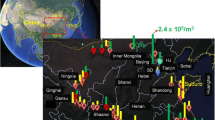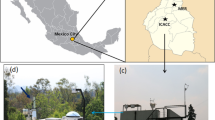Abstract
The viable bacterial particle size distribution in the atmosphere at the Hanford Nuclear Reservation, Richland, WA during two, 1-week periods in June 1992, was observed at three intervals during the day (morning, midday and evening) and at three heights (2, 4, and 8 m) above ground level. The distributions were significantly different (P=0.01) between the two, 1-week sampling periods and between morning, midday, and evening observations, but not between the three heights. Approximately 30 to 50% fell into the largest particle size category; ≥ 7.0µm aerodynamic diameter. All particle size categories were at their minimum bacterial concentration at around noon, with the lowest concentrations in the smaller size categories (<2.1µm aerodynamic diameter). This suggests, that at this high desert location, solar radiation (SR) damage to airborne bacteria is particle size discriminatory. There is a relatively greater effect on the smaller size categories at midday and a relatively lesser effect in the morning and evening.
Similar content being viewed by others
References
Camann, D.E., Moore, B.E., Harding, H.J. and Sober, C.A. (1988) Microorganism levels in air near spray irrigation of municipal wastewater: the Lubbock infection surveillance study. J. Water Pollut. Cont. Fed. 60, 1960–1970.
Cox, C.S. (1987) The Aerobiological Pathway of Microorganisms. John Wiley and Sons. NY. p. 293.
Druett, H.A. and May, K.R. (1968) Unstable germicidal pollutant in rural air. Nature 200, 395–396.
Fengxiang, C. (1985) Killing action of solar radiation on air-microbes. Disinfect. Steril. 2, 101.
Fengxiang, C., Qingxuan, H., Lingying, M. and Junbao, L. (1992) Particle diameter of the airborne microorganisms over Beijing and Tianjin area. Aerobiologia 8, 297–300.
Harm, W. (1969) Biological determination of the germicidal activity of sunlight. Rad. Res. 40, 63–69.
Harm, W. (1980) Biological Effects of Ultraviolet Radiation. Cambridge University Press, UK.
Hinds, W.C. (1982) Aerosol technology. John Wiley and Sons, New York, p. 424.
Hollaender, A. (1942) Abiotic and sublethal effects of ultraviolet radiation on microorganisms. Aerobiol. Publ. 17., Amer Assoc. Adv. Sci., 156–165.
LeClerc, M., Finn, D. and Lamb, B. (1992) Verification of the source footprint model. Presented at the Tenth Symposium on Turbulence and Diffusion, Amer. Meterol. Soc., Portland, OR.
Lighthart, B. (1967) A Bacteriological Monitoring of Sewage on Passage Through an Activated Sludge Sewage Treatment Plant. Doctoral dissertation. Uni. of Washington, Seattle, p. 119.
Lighthart, B. and Frisch, A.S. (1976) Estimation of viable airborne microbes downwind from a point source. Appl. Environ. Microbiol. 31, 700–704.
Lighthart, B., Spendlove, C.J. and Akers, T.G. (1979) Factors in the production, release and viability of biological particles. In: Edmonds, R.L. (Eds.), Aerobiology — The Ecological Systems Approach. Dowden, Hutchinson and Ross., Inc. Sroundsburg, PA, pp. 11–22.
Lighthart, B. and Kim, J. (1989) Simulation of airborne microbial droplet transport. Appl. Environ. Microbiol. 55, 2349–2355.
Lighthart, B., Shaffer, B.T., Marthi, B. and Ganio, L.M. (1991) Trajectory of aerosol droplets from a sprayed bacterial suspension. Appl. Environ. Microbiol. 57, 1006–1012.
Lighthart, B., Shaffer, B.T., Marthi, B. and Ganio, L.M. (1993) Artificial wind-gust liberation of microbial bioaerosols previously deposited on plants. Aerobiol. 9, 189–196.
Lighthart, B. and Mohr, A.J. (Eds.) (1994) Fundamental Principles Describing Atmospheric Microbial Bioaerosols: Theoretical and Applied Aspects. Chapman-Hall, New York, p. 400.
Lighthart, B. and Shaffer, B.T. (1994) Bacterial flux from chaparral into the atmosphere in mid-summer at a high desert location. Atmos. Environ. 28, 1267–1274.
Setlow, R.B. (1974) The wavelengths in sunlight effective in producing skin cancer: a theoretical analysis. Proc. Natl. Acad. Sci. USA 71, 3363–3366.
Sokal, R.R. and Rohlf, F.J. (1969) Biometry. W.H. Freeman, San Francisco, CA. p. 776.
Stull, R.B. (1988) An Introduction to Boundary Layer Meteorology. Kluwer Academic Publishers, Boston, p. 666.
Willeke, K. and Baron, P.A. (Eds.) (1993) Aerosol Measurement — Principles, Techniques, and Applications. Van Nostrand Reinhold, New York. p. 876.
Wolf, H.W., Skaliy, P., Hall, L.B., Harris, M.M., Decker, H.M., Buchanan, L.M. and Dahlgren, C.M. (1959) Sampling Microbiological Aerosols. Public Health Monograph No. 60, U.S. Dept. Health, Education and Welfare, Washington, D.C. p. 53.
Yee, E. and Ho, J. (1990) Neural Network Recognition and Classification of Aerosol Particle Size Distributions. Rpt. No. 531. Canadian Defence Res. Establishment, Ralston, Alberta, p. 12.
Author information
Authors and Affiliations
Rights and permissions
About this article
Cite this article
Lighthart, B., Shaffer, B.T. Viable bacterial aerosol particle size distributions in the midsummer atmosphere at an isolated location in the high desert chaparral. Aerobiologia 11, 19–25 (1995). https://doi.org/10.1007/BF02136140
Received:
Accepted:
Issue Date:
DOI: https://doi.org/10.1007/BF02136140




